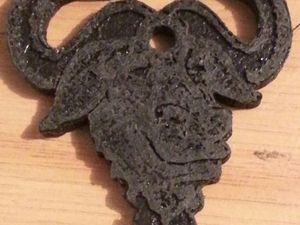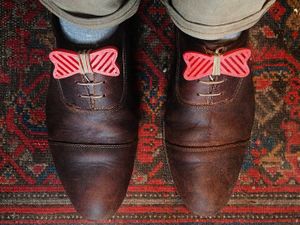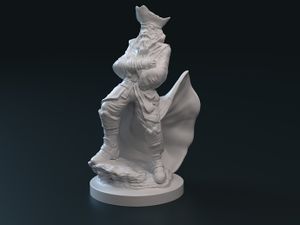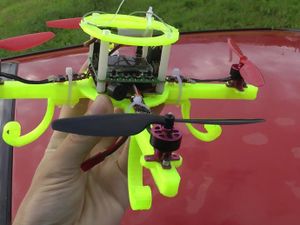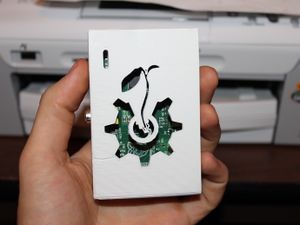User:Bxl5138
Contents
Introduction
My name is Brandon Leshchinskiy. I'm a sophomore at The Pennsylvania State University, majoring in Electrical Engineering and minoring in economics, entrepreneurship, or something similar. Ultimately, I hope to work at a technical company in a nontechnical position.
Blogs
Blog posts will be written weekly. These will be based on prompts given by the professor, and generally will concern RepRapping.
Blog Number One
Part A
An item that is useful
I don’t think a key ring yet exists that would prevent me from losing my keys, but this comes pretty close. It’s unique, goofy, and looks awesome. [1]Part B
An item that is useless
While these shoe bowties are absolutely useless, they are doubtlessly my favorite item I’ve found on Thingiverse thus far. Seriously, what’s classier than a plastic bow tie on each foot? [2]Part C
An item that is amazing
I think this print is appropriate for the amazing section for a multitude of reasons. First and foremost, the detail is stunning – especially given the relatively young age of 3D printing. Secondly, pirates are objectively badass. That’s enough for me, really. [3]Part D
An item that is funny
I suppose the object itself isn’t inherently funny, but when you consider all the possibilities of a 3D printed quadrocopter, it certainly becomes enlivening. I’m picturing a fleet of them flying into an introductory chem lecture, narrowly missing the professor, and then zooming out of the room. That’s not a terrible idea, right? [4]Part E
A great Raspberry Pi case
This case is not only sleek and aesthetically pleasing, but the holes enhance functionality by preventing overheating. Still, it seems simple enough to print that it wouldn't cause any impossible issues. [5]Blog Number Two
The Economic Impact of 3D Printing
One of the most interesting aspects of 3D printing, in my opinion, is the effects it will have on the global economy. Since the industrial revolution, our process for making new products has been more or less the same: build a prototype by hand or in a machine shop, adjust and improve it, and then use a factory to manufacture it on a large scale. 3D printing will revolutionize the prototyping stage of this process. Rather than working manually to create the prototype, companies will simply be able to print their CAD designs and test them.
Because this is clearly a more efficient method of prototyping, it is predicted to spread quickly through the industrial world. Indeed, according to this video, the 3D printing industry will become a $3B business by 2016. This is pretty mind-blowing, given the relatively young age of additive manufacturing.
Part of this, of course, will be simply by virtue of the careers offered by 3D printing companies, in addition to the actual hardware they produce. Another economic benefit, however, will be the creative outlet 3D printing will become for millions of people. That is, anyone with an idea for a new product and access to a 3D printer can simply design and create their idea. The expenses associated with product creation will be practically nullified, allowing average men and women to engage in invention. Overall, the proliferation of 3D printers will offer huge financial and creative benefits to millions, if not billions, of people.
Blog Number Three
Blog commentary While many of the blog posts have been insightful and interesting, one of my favorites is Steven Rekstad's post about deep space travel and 3D printing, which can be found here: http://reprap.org/wiki/User:StevenRekstad. He does a great job illustrating a very practical application of 3D printing, and while the post is specifically about deep space travel, the notion that 3D printers can replace spare parts in general -- because you can just print any part you need -- is, quite frankly, awesome. His post is clearly well thought-out and well-written, but one improvement to be made with the blog as a whole is to add a table of contents. This would make it easier to view and link to specific sections or posts, not to mention improving the overall professionalism. Still, the content itself is very well done.
Blog Number Four
Arduino and RepRap Arduino and RepRap are, in my opinion, among the coolest inventions of the last few decades. The Internet allowed people to share information with each other for free, and these projects now allow people to take it a step further; between the Internet, RepRapping, an Arduinos, people can make basically whatever tool they want by using someone else's design, and then programming it to do whatever they need. In terms of the business model, giving away the main product for free is certainly non-standard. Many businesses give away various side products -- complements to their main offer -- but these open source businesses have basically turned this idea on its head. It's evidently effective enough, as they are clearly profitable. Take Google as a case in point: their main service, organizing and retrieving information, is completely free. However, by allowing advertisers access to the types of searches people are doing, Google has become a billion dollar company. As an aspiring entrepreneur, I can definitely appreciate the ingenuity of this business model. This, not to mention the fact that open source hardware will (and has already started to) revolutionize the industrial world.
Blog Number Five
The main differences between patentable and copyrightable products are that, to merit a patent, the idea must be useful and original, while to gain copyright, the idea must be creative and inherently artistic. Accordingly, I've analyzed my five things from post 1 to decide whether there are facets of them that may be under copyright or patent protection.
1. Gnu Key-ring. While the idea of a key ring is certainly not original, the actual design may be. Therefore, the artistic part of the key ring -- the gnu's face -- may be copyrighted.
2. Shoe Bow ties. Bow ties are obviously not original, nor are these plastic versions particularly useful. Therefore, I doubt that this design is subject to any protection at all.
3. Plunderbuss Pete. This is one of the coolest sculptures I've ever seen, and, while it's clearly not useful in any way, it's equally clearly a beautiful work of art. It should absolutely be protected by a copyright.
4. Quadrocopter. If this were the first of its kind, it might merit a patent. However, as this is simply a quadrocopter that used 3D printed parts, it has added nothing creative or useful to the design.
5. Raspberry pi case. This is not under patent protection, because it is not the first raspberry pi case. However, the design is unique and original enough that it may merit copyright protection.
I also checked out some of my classmate's blog post. Dimitri's sculpture (http://www.thingiverse.com/thing:145913) is really neat, and obviously a unique work of art. I would assume this is protected by copyright, since it is so original and beautiful. On the opposite of the spectrum, Brandon's gear bearing (http://www.thingiverse.com/thing:53451) seems like it is new, original, and very useful. It may be under patent protection.
As for the benefits of licensing, I have a few opinions. While I am a bit skeptical about "future-proofing" anything -- the legal system is fantastic at circumventing the law -- I think the idea of licensing to encourage an open-source community is awesome. It's what led to 3D printers in the first place, and I believe this kind of creative, helpful community should be encouraged and stimulated.
Lastly, I believe the author of the first article may be slightly naive in that he did not seem to consider the fact that the Penrose Triangle is an optical illusion from the 1950's. The design is clearly not useful, and nor is the 3D printed version of it original. Therefore, it was probably not even protected by copyright law in the first place.
Blog Number Six
This blog is an update of the previous post regarding 3D printing, IP, and the Penrose triangle. A classmate wrote about a raspberry pi case, saying it's possible for the case to be patent-able because it serves a unique purpose. I, however, disagree with this, because raspberry pi cases all have the same fundamental purpose: protecting the raspberry pi from mechanical and thermal damage.
Another comment that was made was the realization that the license would last for years, even though copyright law may change. This blog also made note of the creative commons license, which encourages a creative atmosphere that is conducive to collaboration and innovation. This is quite important, and I made note of this in my previous post as well.
As for the Penrose triangle, another blogger pointed out an observation that I also made -- even though someone printed the Penrose triangle, he cannot patent it or copyright it because it wasn't his original design, and it certainly serves no useful purpose. Overall, the articles clearly offer many important points in regards to intellectual property, patents, and copyright.
Blog Number Seven
3D printing has obviously taken over quite a bit of popular science media real estate as of late, not in the least because of its seemingly endless possibilities. Take, for example, the application of 3D printing to food (as enumerated in this article [6]).
The article discusses a wide range of food-based applications for additive manufacturing, and, as is usually the case with popular science articles, it mixes "hope" and "hype" to provide for an informative, yet entertaining read. In terms of hope -- how 3D printing will save the world -- the article points out the possibility of manufacturing meat. Clearly, this would reduce methane emissions from farms, not to mention our growing need for more land. There are two issues with this concept that push it towards the category of "hype," however: firstly, producing even a pound of meat currently takes thousands of dollars, and secondly, convincing the general populace to eat industrially manufactured meat will require a marketing campaign of biblical proportions. Still, one could suppose that in the not-too-distant future, both of these issues will be overcome.
Besides these typical overblown expectations, I believe the smaller applications mentioned in this article are perhaps more relevant to today's world. For example, printing chocolate and cheese into unique designs could be a highly profitable business venture, particularly if marketed to the "1%" who can afford to spend lavishly on such novelty items. A bit more usefully, 3D printed food could also turn pureed foods back into their original shape, for consumption by the elderly. Furthermore, the articles notes the idea of 3D printing custom combinations of nutrients for athletes, pregnant women, and other targeted groups. This begins to border on "hype" again, and I am somewhat skeptical about replacing natural foods with 3D printed alternatives -- particularly when diet pills already abound -- but I believe this use for additive manufacturing might be adopted in some niche industries.
Overall, this article effectively describes the many applications of 3D printers with regards to our diet. Although it adopts a "This will save the world" attitude towards some uses, it generally presents a reasonable discussion of future possibilities.
Blog Number Eight
Although the AMRI research lab is doing many interesting research projects, it seems unlikely that we have the resources available to replicate them. For instance, it would be fairly difficult to attempt 3D printing with bacteria in our current workshop, and stereolithography is quite an expensive process. I suggest, therefore, that our best bet in terms of a new research project would involve using a laser to sinter thermoplastic powder.
As for words that might relate to our class, I suggest the following:
integration
synthesis
manufacturing
collaboration
students
lion
technology
extrusion deposition
Finally, I've thought of the following acronyms to describe our activities:
LEAD: Lions Engineering through Additive Design
DARE: Designing with Additive Reprap Engineering
SMART: Students Manufacturing with Additive Reprap Technology
AMURICA: Additive Manufacturing: Undergraduates Reprapping and Integrating Cool Advancements
Blog Number Nine
The assigned article discusses how one maker used a 3D printer and "as few specialized parts as possible" to make his own coffee grinder, in addition to other kitchen appliances. This highlights one of the many practical applications of 3D printing, especially for average people. In other words, while additive manufacturing is clearly an important development for how manufacturing companies prototype, this article demonstrates the practicality of 3D printers for normal households. Thus, a tremendous benefit of owning a 3D printer is that it can be used to print replacement parts, as well as entire systems -- coffee grinders, shower heads, blenders, etc. -- with the help of some non-printed parts.
One place this might have an impact is for the companies who produce kitchen appliances and similar devices. It is unlikely that they will be replaced by 3D printed machines entirely, but, as 3D printers become more popular, these companies may have to alter their business models slightly. For example, in addition to selling fully built appliances, they might also offer parts that are not suitable for 3D printing. That is, the "specialized parts" mentioned earlier could be produced and sold by the companies who also supply fully built appliances. This way, companies could appeal to both the current mass market, as well as to the growing population of makers.
A general trend in manufacturing is that, as quantity produced increases, the price follows an upside-down parabola, the precision follows a line sloping upwards, and labor intensiveness follows a line sloping downwards. Thus, it almost always more efficient to produce objects in bulk quantities than one at a time, largely because more production allows for more usage of international trade and competitive advantage. That is, a company could gather bulk supplies from the country who is best at supplying them; a maker, however, would probably settle for the most easily-accessible materials. The ultimate problem with this is, if one person wants to make himself a coffee grinder, there's no reason to produce an extra 999 of them -- this is why individuals cannot reap the benefits of mass production.
